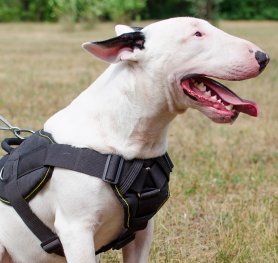
The basis of Bull Terrier breeding began to emerge from the turn of the nineteenth century. At that time the focus was based on further development and improvement of Bull Terriers and breeding of new types of this breed. As it turned out, and confirmed in practice, the best fighting dogs originated from the cross breeding of Bulldogs with different Terriers. As a result, their offspring retained the courage, grit and stoutness of a Bulldog, gaining agility, dexterity and subtle mind of a Terrier. In general, dogs of those years were distinguished with a massive, brick-shape head, evil, unfriendly look and a wide variety of colors including white, famous as "Bull and Terrier".
Over time they had gained more and more clear features of Terriers: snout sharpness, and long legs. A growing preference is given to dogs of white color, as the most pure-bred. White dogs bred by an Englishman, James Hinks, has eclipsed all dog of other colors demonstrated at the exhibition in 1862.
Dog breeders owed James Hinks for breeding of more elegant dogs, that were quite unusual in the end of the century. According to historical records, these dogs distinguished with elegance and grace, without any signs of limbs distortion or presence of colored spots. That means that Hinks practiced outcross breeding with white English Terrier. Most people blamed him for the blood flowing of other breeds that allegedly led to a decrease of fighting spirit, that was considered as the most valuable feature of this breed. However, Hink's dogs have not lost a single drop of this precious quality, and it was confirmed in a very stunning way. Hinks bet five pounds and a box of champagne on his bitch Puss, weighing about 18 kg, against a female old-type Bulldog weighing about 27 kg. The fight took place in Long Acre Hotel. Half an hour later Puss killed her rival, having received insignificant damage that the next morning she was shown at a dog show, earning the prize for the exterior and standard.
Several comments from this exhibition were published in the American magazine "Doghouse". They belong to Hink's son, James Jr. He wrote: "The ancestors of my father's dogs, had short, massive heads, blunt, like a Bulldog muzzles, barrel-shaped limbs, compact body and flabby lips, they looked ridiculous in contrast with other dogs of different colors. They were called "Bull and Terrier" because they were bred from the cross of Bulldogs with Terriers. In appearance they looked like a defective version of a Bulldog and a Terrier, but they coped well with their duties, which they were bred for, like fighting, baiting of rats, hamsters and bulls. This offspring was perfect, combining the power and strength of the Bulldog with Terrier intelligence.
By the end of the 1950s there was a great event. My father, who reserved the best dogs from each litter, had carried out the experimental crosses with white English Terrier and Dalmatian, and finally brought the family of pure-white dogs, calling them "Bull Terrier". These dogs weighed less than a Bulldog, almost lost its features: their head became longer and smoother (no damp skin, bumps and depressions), snout was stronger and more powerful, with no protruding lips and dewlap, neck became longer, and temperament - more energetic. In short, there appeared a more civilized and sophisticated fighting dog that kept all its best qualities: vigilance, energy and courage."
In the pedigrees of those years there is complete chaos. To say exactly what combination of breeds Bull Terrier originated from, is impossible. However, it is well established and confirmed by James Hinks Jr. that his father mainly used for crossbreeding old-type Bulldogs, white English Terriers and Dalmatians. Perhaps he also crossed Greyhound, Spanish Pointer and Foxhound, as it is known that back in the 1930s, Bull Terriers occasionally born with ears like a hound.
Wait a minute!
You can take this promo code for a realy good deal
5VISPZLM -3%CLICK ON THE CODE TO COPY